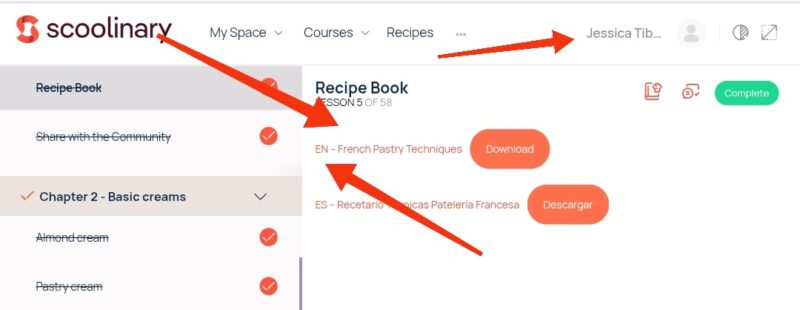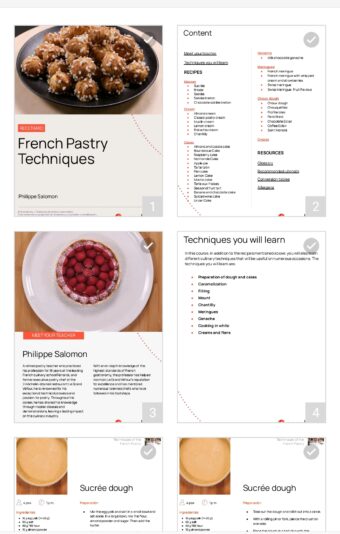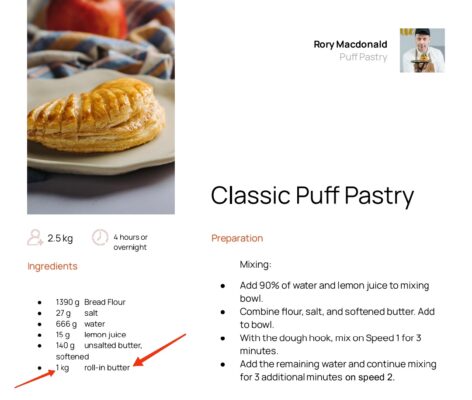Forum Replies Created
-
Level:
Scoolinary Team
Hi Hanan.
Welcome to the Scoolinary community!
This solid sourdough by Xevi Ramon is more of a pre-fermented dough or preferment made with commercial yeast and left to chill in the fridge to develop flavor. Since it doesn’t go through feedings, you can’t easily adjust it in future refreshes as you would with a traditional sourdough starter.
Since you’ve already made it using all-purpose flour, your bread will still bake, but it may have some differences:
1. Less strength in the dough: The structure may be weaker, leading to a less voluminous loaf.
2. Faster fermentation: All-purpose flour absorbs less water, so the yeast activity might be more intense.
3. Softer texture: The bread may be less chewy, with a tighter crumb.
What can you do?
If the dough is already in the fridge: Go ahead and use it, but keep an eye on the final fermentation. If it rises too quickly, shorten the proofing time to avoid over-fermentation.
When shaping your bread: If the dough feels too weak, consider adding extra folds during the bulk fermentation to strengthen the gluten.
If you haven’t baked with this starter yet: I recommend doing a small test batch before making a full-sized loaf. Use a smaller portion of dough to bake a test loaf and check its structure, fermentation, and flavor. This will help you determine if any adjustments are needed before using the entire batch for a larger production.
This isn’t a major issue,your bread will still turn out fine, but the texture may be slightly different from usual.
I hope this helps! Let me know if you have any other questions, and I’ll be happy to assist you.
Best regards.
-
Level:
Scoolinary Team
Hi Christofer.
Welcome to the Scoolinary community!
It seems there is some confusion about the order of the process. What the chef does is first prepare the biga (a “dry” or low-hydration pre-ferment) 24 hours in advance and then, the next day, use that biga in the final dough mixing.
Biga is a pre-ferment that enhances the dough’s flavor, structure, and digestibility. It’s not that one dough is made without biga and another with it; rather, the recipe follows this process:
1. Day 1: The biga is prepared and left to ferment in the fridge for 24 hours.
2. Day 2: The biga is incorporated into the final dough through an indirect mixing method, where it is combined with more flour, water, and salt.
In short, there are not two separate doughs; the final dough is a single dough that is developed in two stages: first, the biga (dry pre-ferment), and then the final mixing with it.
Let me know if this explanation clarifies the process, or if you have any other questions,I’m happy to help!
Best regards.
-
Sussan Estela Olaya
AdministratorMarch 23, 2025 at 14:32 in reply to: Missing ingrédients and technique in the pear and pistachio puff pastryLevel:Scoolinary Team
Hi Caline.
Welcome to the Scoolinary community!
You can find the written recipe and procedure for the pistachio frangipane used in the Pear and Pistachio Danish recipe on page 14 of the same recipe book. This recipe is part of the Pistachio and Raspberry Galette recipe.
I hope this information is helpful. If you have any other questions, I’m here to assist you.
Best regards.
-
Sussan Estela Olaya
AdministratorMarch 23, 2025 at 14:18 in reply to: French Pastry Techniques Recipe BookLevel:Scoolinary Team
Hi Jessica.
Welcome to the Scoolinary community!
I reviewed the course from your account and was able to download the recipe book in English.
Here’s the direct link so you can download it:
https://www.scoolinary.com/courses/french-pastry-techniques/lessons/recipe-book-66
If you have any other questions, I’ll be happy toh help!
-
Level:
Scoolinary Team
Hola Daniela.
¡Te damos la bienvenida a la comunidad de Scoolinary!
Sí, lo que sobra de la mezcla del día 1 (y de los días siguientes) se desecha. La idea es mantener una cantidad manejable de masa madre en formación y evitar que crezca en volumen de forma excesiva.
Cada día, solo tomas 50 g de la mezcla del día anterior y lo mezclas con los nuevos 80 g de agua y 50 g de harina integral ecológica. Lo que reste de la mezcla del día anterior debe desecharse.
Este proceso se llama “refrescado” y ayuda a fortalecer la actividad de los microorganismos presentes en la masa madre. Eliminar el exceso permite que la población de levaduras y bacterias beneficiosas se mantenga en equilibrio sin que haya una acumulación excesiva de subproductos de la fermentación.
Si no quieres desecharlo, puedes usar el descarte en recetas como panqueques, crackers o waffles, pero al ser una masa madre en formación, es posible que aún tenga un sabor poco desarrollado.
Espero que esta información sea de ayuda.
Saludos.
-
Level:
Scoolinary Team
Hola Cesar.
¡Te damos la bienvenida a la comunidad de Scoolinary!
Podrías indicarme por favor , ¿cuál receta y curso en específico te refieres ?.
Así puedo revisar el material y ayudarte con una respuesta a tu consulta.
Saludos.
-
Level:
Scoolinary Team
Hola Sherlyn.
¡Te damos la bienvenida a la comunidad de Scoolinary!
Sí, hay una diferencia entre la levadura de supermercado y la que se usa en el curso para la pizza napolitana.
La receta del curso menciona levadura de cerveza fresca, que es lo mismo que la levadura fresca prensada. En los supermercados, generalmente se encuentran tres tipos de levadura:
1. Levadura fresca prensada (igual a la del curso)
2. Levadura seca activa (necesita activarse con agua)
3. Levadura instantánea (se mezcla directamente con la harina)
Si solo consigues levadura seca o instantánea, puedes sustituir la cantidad de levadura fresca siguiendo estas equivalencias:
2 g de levadura fresca = 0.66 g de levadura seca activa (aprox. ⅓ de la cantidad de levadura fresca)
2 g de levadura fresca = 0.5 g de levadura instantánea (aprox. ¼ de la cantidad de levadura fresca)
Si usas levadura seca o instantánea, disuélvela en el agua antes de incorporarla o mézclala directamente con la harina, según el tipo.
El resultado final puede variar ligeramente porque la levadura fresca tiene un perfil de fermentación algo diferente, pero en general, la conversión funciona bien.
Espero que esta información sea de ayuda.
Saludos.
-
Sussan Estela Olaya
AdministratorMarch 23, 2025 at 02:01 in reply to: Sepia y melsa para marca de arrozLevel:Scoolinary Team
Hola María.
¡Te damos la bienvenida a la comunidad de Scoolinary!
Para poder darte una respuesta más precisa, ¿podrías indicarnos a qué receta te refieres exactamente? Así puedo revisar el material y asegurarme de darte la mejor recomendación.
Mientras tanto, aquí te dejo algunas respuestas generales a tus dudas:
1. Tiernizado de la sepia: No es obligatorio congelarla previamente, pero hacerlo puede ayudar a romper las fibras y hacerla más tierna. Otra técnica es cocinarla a fuego lento por un tiempo prolongado o, por el contrario, cocinarla a fuego muy alto y rápido para evitar que se endurezca.
2. Obtención del líquido de la melsa: Para extraer el líquido, basta con romper la telilla que la envuelve y presionar ligeramente. Si el interior está demasiado espeso, puedes mezclarlo con un poco de agua o caldo para que sea más fácil de integrar en la receta.
Si nos confirmas la receta, podemos darte indicaciones más detalladas.
Me quedo atenta a tu respuesta.
Saludos.
-
Level:
Scoolinary Team
Hola Natalia.
¡Te damos la bienvenida a la comunidad de Scoolinary!.
Si quieres usar merengue como cubierta para una tarta de limón, lo ideal es aplicarlo justo antes de servir o asegurarte de que sea un merengue estable, como el italiano o el suizo, que tienen mejor resistencia a la humedad. Si en el video mencionan que no debe refrigerarse es porque los líquidos pueden separarse, lo que ocurre principalmente con el merengue francés o si hay cambios bruscos de temperatura.
Si me cuentas qué receta o curso estás siguiendo, puedo revisar el material y darte una respuesta más precisa para que el merengue quede perfecto en tu tarta.
Saludos.
.
-
Level:
Scoolinary Team
Hi zhengyi xing.
Welcome to the Scoolinary community!
To create the top decoration for the tart, a thin sheet of white chocolate is used, worked with a stencil and airbrushing technique.
The process is as follows:
1. Preparing the white chocolate sheet
Temper the white chocolate and spread it over an acetate sheet or silicone mat in a thin, even layer.
Before it fully hardens, cut a circle to the desired size.
Once crystallized, cut the circle into a half-moon shape so it fits the decoration.
2. Creating the lemon segment effect
Use an acetate sheet or a stencil with the segmented lemon pattern.
Place the stencil over the chocolate sheet.
Using a chocolate spray gun, spray white chocolate tinted yellow over the stencil, ensuring the pattern is well-defined.
3. Assembly and placement
Carefully remove the stencil.
Allow the airbrushed chocolate to dry and fully crystallize before handling.
Place the decoration on the tart, using a bit of tempered chocolate if needed to secure it.
This technique ensures a clean and professional finish, enhancing the visual effect of the lemon.
Best regards!
-
Sussan Estela Olaya
AdministratorMarch 22, 2025 at 15:10 in reply to: Missing ingredientin puff pastry doughLevel:Scoolinary Team
Hi Caline.
Welcome to the Scoolinary community!
Could you please rephrase your question and let us know which ingredient is missing from the recipe? Also, I’m not sure what you mean when you say, “How much better should we add in the lamination process?” Could you clarify?
Additionally, please specify which recipe or course you are referring to so I can review the material and provide a helpful answer.
Best regards.
-
Sussan Estela Olaya
AdministratorMarch 23, 2025 at 02:19 in reply to: Missing ingredientin puff pastry doughLevel:Scoolinary Team
Hi Caline.
Welcome to the Scoolinary community!
Thank you for the information,I reviewed Chef Rory Macdonald’s Puff Pastry course.
In the recipe book, on pages 5 and 6, you can find the amount of butter needed for laminating. The chef specifies using 1 kg of roll-in butter.
Let me know if you can see the amount of butter for laminating in the recipe.
I hope this information is helpful. If you have any other questions, I’m here and happy to help.
Best regards.
-
Level:
Scoolinary Team
Hola Estefanía.
Tanto el cheesecake Japones, tradicional y cheesecake vasco o San Sebastián se hornean de distancia forma.
El Cheesecake japonés y tradicional en algunas recetas necesita de vapor para que quede húmedo y esponjoso y en el caso del cheesecake tradicional no se agriete en el medio, por eso se usa baño María y en el cheesecake Vasco se necesita calor seco para que se forme la costra característica.
También quería comentarle que no es que no queramos darte el peso en tazas, sino que estas recetas, especialmente las de pastelería, requieren precisión. La chef las ha formulado de esta manera para asegurar buenos resultados. Si convertimos la receta a tazas u otra medida o te sugerimos una medida aproximada es muy probable que las cantidades sean inexactas, y no queremos llevarte a un error y que pueda afectar el resultado de tu preparación lo cual llevaría a un desperdicio de ingredientes.
Por eso, recomendamos a los alumnos adquirir una balanza básica de pastelería y un termómetro para horno, ya que son herramientas esenciales cuando se inicia en este mundo se la pastelería.
¡Quedo atenta por si tienes alguna otra consulta!
Saludos.
-
Sussan Estela Olaya
AdministratorMarch 22, 2025 at 14:38 in reply to: Bread Making Basics Course Doesn’t stream in EnglishLevel:Scoolinary Team
Hi Shellie.
It’s great to hear that you found a solution! As I mentioned, I’ll be forwarding all the information you’ve shared to the team in charge, and I’ll get back to you as soon as I have any updates.
Best regards.
-
Sussan Estela Olaya
AdministratorMarch 22, 2025 at 14:32 in reply to: Bread Making Basics Course Doesn’t stream in EnglishLevel:Scoolinary Team
Hi Shellie.
That’s interesting information, and I’ll make sure to share it with the team in charge. I’ll most likely have an answer to your inquiry by Monday or Tuesday, as the team works from Monday to Friday. As soon as I have a response, I’ll get back to you.
Thank you for your message and for letting us know about this issue.







